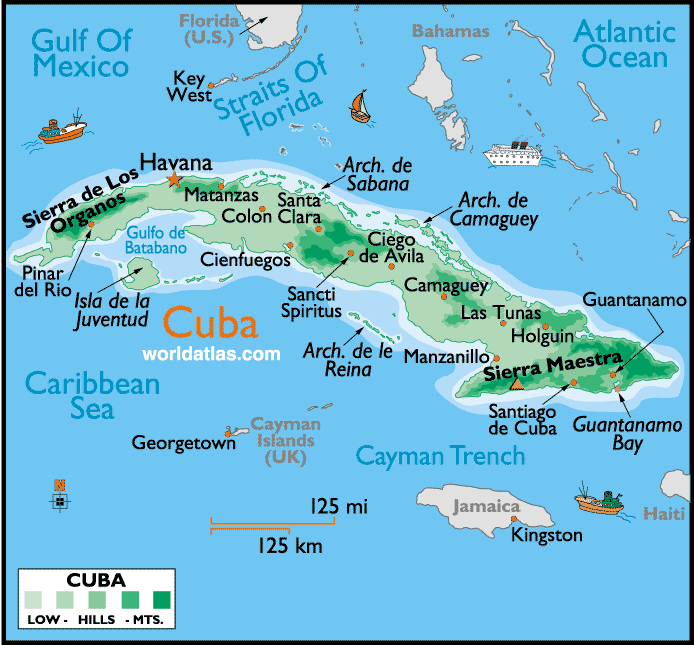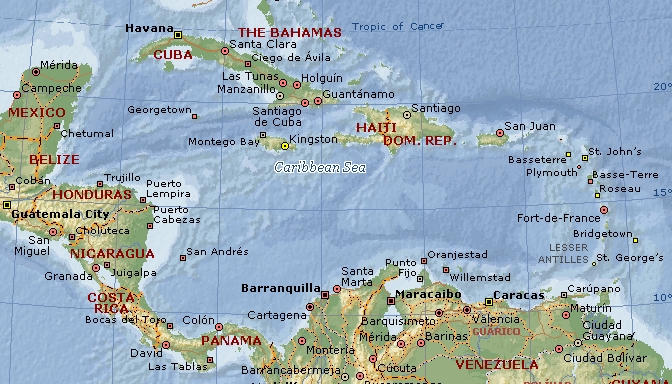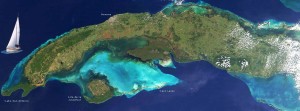Norman Frey
Cuba *
Cuba is a Caribbean island favoured by some as a serious contender for the location of Atlantis.
” A two-page article appeared in the February 1952 edition of the magazine ECOS entitled ’Formó Cuba Parte de la Atlándida?’. Written by Francisco Garcia-Juarez, the press secretary of the Instituto Cubano de Arqueologia (Institute of Cuban Archaeology, or ICA) it posed the question: did Cuba once form part of Atlantis? He explained how members of the Institute were investigating the idea that traces of an Atlantean culture might be found in Cuba and Hispaniola.” This study had been prompted by a suggestion from Egerton Sykes(e).
Some years ago, Leicester Hemingway, the brother of Ernest, claimed to have spotted off the northern coast of Cuba “an expanse of stone ruins, several acres in area”.
 In more recent years, it was reported that Paulina Zelitsky and her team of underwater explorers found formations, in 2000 feet of water off the western tip of Cuba that resembled submerged cities.
In more recent years, it was reported that Paulina Zelitsky and her team of underwater explorers found formations, in 2000 feet of water off the western tip of Cuba that resembled submerged cities.
Although there was a widespread media reaction to Zelitsky’s discovery, many commentators drew parallels with Plato’s city of Atlantis. However, Zelitsky was unwilling to make such comparisons. The story is a myth, said Zelitsky.“What we have found is more likely remnants of a local culture”, once located on a 100-mile “land bridge” that joined Mexico’s Yucatan Peninsula with Cuba.
Although further explorations were planned it is reported that the U.S. government applied pressure to have any further funding denied. May 2013 had Zelitsky trying to revive interest in her theories in an interview with Luis Mariano Fernandez(d). However, in 2012, Andrew Collins offered a different account of the Zelitsky funding difficulties(g).
Barry Warmkessel, who is normally just concerned with the threat to Earth posed by asteroids and comets, digressed slightly in an illustrated paper updated in 2015(l). He discusses in great detail the possible destruction of Atlantis by a comet/asteroid impact off the west coast of Cuba.
Andrew Collins is probably the best-known supporter of a Cuban Atlantis. His book[072] and website(a) list eleven points in favour of this theory. He contends that Cuba’s western plain, which stretches from Havana westwards to Pinar del Rio was the great Plain of Atlantis described by Plato. He believes that the main city was located near the present Isle of Youth (Isla de la Juventud) situated in the south of the island. In 2009 Norman Frey wrote a paper(b) supporting the Gulf of Batabanó which lies north of the Isle of Youth as Atlantis’ location at the end of the last Ice Age. He supports his contention with satellite images and the work of Dr Christine Pellech. Frey also claims that the two plains of Cuba match Plato’s description of the Plain of Atlantis(k).
A.R.E. is also a supporter of Cuba as a possible location for the capital of Atlantis. They have suggested an underwater ‘island’ at Zapata, located on the southern side of Cuba, north of the Isle of Youth and just to the west of the infamous Bay of Pigs. This ‘island’ is surrounded by a small ring of water and is about 7 miles in diameter, consistent with Plato’s description of the outer ring of Atlantis. A.R.E.’s Greg Little obtained old depth and bottom contour charts of the site and found that the island was comprised of a series of rings. Little also identified other features in the locality that match Plato’s story; ancient manmade canals north of the underwater island. These canals have been attributed to the Taino Culture, a mound-builder culture present in Cuba about 3,000 years ago that became extinct shortly after the Spanish conquest. Further north there is a mountain range enclosing the area with a wide river running at its base — a further match with Plato. Little also found that the centre of the underwater island is not only the tallest portion but also has several springs on it.
One completely off-the-wall suggestion has been that the Cuban Missile Crisis was instigated to prevent the Soviets from finding Atlantis(f)!!
A project to compile an archaeological Atlas of Cuba has so far identified over 3,000 pre-Columbian sites. Cuba’s westernmost province, Pinar del Rio and the central region of Villa Clara have the highest density of sites, with 500 each(c).
Gerard W.J. Janssen of Leiden University places the voyages of Odysseus in the Atlantic(i). However, although he situates most of the places visited in the eastern Atlantic he does claim(h) that Homer‘s Laestrygonians were to be found in Cuba, an interpretation supported by both Théophile Cailleux and Iman Wilkens.
Luigi Usai has recently (2022) published a number of images purporting to show underwater anomalies off the coast of Cuba(j). As Usai has already designated the central region of the Mediterranean as the location of Atlantis I cannot understand his reason for showing such images. Similar anomalies have been found in various parts of the world and explained by Google as data-gathering glitches (see Satellite Imagery). If any of the rectangular features were city walls or streets they would have been kilometres thick/wide – a nonsensical suggestion.
(a) Atlantis (archive.org) *
(b) https://www.migration-diffusion.info/article.php?id=162
(c) Archive 2952 | (atlantipedia.ie)
(d) https://wolfke74.wordpress.com/2013/05/31/atlantis-found
(e) https://thewadeword.wordpress.com/tag/bimini/
(f) Archive 2462
(g) https://www.abovetopsecret.com/forum/thread374842/pg11
(h) LAISTRUGONIACUBA, LA HAVANA (homerusodyssee.nl)
(i) https://www.academia.edu/38535990/ATLANTIC_OGUGIA_AND_KALUPSO?email_work_card=view-paper
(j) Cuba high resolution bathymetry – Atlantis exists! Found by Dr. Luigi Usai (atlantisfound.it)
(k) The level of Atlantis – Atlantisforschung.de (atlantisforschung-de.translate.goog)
(l) THE ATLANTIS CATASTROPHE – Plato Was Right (archive.org)
Caribbean
The Caribbean Region with the many islands of the West Indies is favoured by a number of authors who find in the writings of classical writers evidence of very early knowledge of the islands in the western Atlantic by the peoples of the Mediterranean. As a source, these ancient authors have to be treated with great care, as so much of the historical and geographical details are at best second-hand and sometimes just conjectural if not fictional. This is compounded by the fact that so many of these early writers borrowed from each other so that an early ‘fact’ that is erroneous could be transmitted unchecked for centuries if not permanently.
 The seas around many of the Caribbean Islands are quite shallow indicating that during the last Ice Age the exposed land area must have been considerably larger. If Atlantis existed in this region there are many candidate locations.
The seas around many of the Caribbean Islands are quite shallow indicating that during the last Ice Age the exposed land area must have been considerably larger. If Atlantis existed in this region there are many candidate locations.
>Geoffrey Ashe noted that in the 5th century, the neo-Platonist Proclus, quoting a 1st century BC geographer named Marcellus, spoke of three islands of ‘immense extent’ located in the Atlantic Ocean. The inhabitants of the centre of these islands were said to have preserved the memory of a former landmass, identified by Proclus with Atlantis, which had existed thereabouts. In 1962, in Land to the West [740] historian Ashe identified Marcellus’ three great islands with the Greater Antilles of the Caribbean. Moreover, he pointed out that the indigenous peoples of the region preserved the memory of a cataclysm, which had split up a former landmass leaving behind the islands that make the archipelagos, which we have today. All but a few human beings were drowned in this all-encompassing event. Could this have been a memory of the destruction of Atlantis preserved in the Caribbean and brought across the Atlantic by ancient mariners such as the Phoenicians and Carthaginians?<
>Atlantisforschung has drawn attention to the work of Harold T. Wilkins who, in 1952 had pointed out the mythology of the islanders of the West Indies in Secret Cities of Old South America [364], and in particular to the almost astonishing similarities between West Indian-Caribbean and Irish myths. Wilkins also noted: “In the hinterland of the British West Indies island of Trinidad, the Natives of Aboriginal origin affirm that Trinidad is a very old country, and formed part of ‘the greatest country in the world’ many thousands of years ago. This was a time ‘when there was no sea at all’. This large, antediluvian country or continent is called IERE by the natives, which is pronounced almost exactly like EIRE for Ireland. And ancient Trinidad too, the natives say, was known as Iere before the great cataclysm that sank the lost continent” (e).<
>Gonzalo Fernández de Oviedo y Valdés writing in the 16th century[1117] considered the Antilles in the Caribbean to have been the legendary Isles of Hesperides. Andrew Collins also identified Cuba as one of the Hesperides.<
An American researcher, Amy Smith, has produced a website claiming that Atlantis had been located on a now demolished landbridge linking Cuba with the Yucatan Peninsula, in the Caribbean and was destroyed at the end of the last Ice Age when the Mississippi was dramatically swollen by meltwater from the retreating glaciers and poured into the Gulf of Mexico, which was then an enclosed sea. This in turn led to the breaching of the landbridge linking Cuba and the Yucatan Peninsula and the destruction of Atlantis in its vicinity. Smith has recently expanded on the events leading to the destruction of Atlantis(b).
Edgar Cayce’s followers in A.R.E. have focused their attention on the Bimini sector of the Bahamas, although Greg Little opted for a location just north of the Isle of Youth off Cuba. Andrew Collins is also convinced that Atlantis was in located near the Isle of Youth, while, more recently, Norman Frey has added his support to the same locality. Mel Fisher claimed to have found Atlantis in the vicinity of Cuba but failed to reveal the exact location before his death. The Italian researcher, Emilio Spedicato, has chosen the nearby island of Hispaniola.
Gábor Bihari, the Hungarian researcher, submitted a paper to the 2008 Atlantis Conference outlining his view that Plato’s Atlantis story was loosely based on reports of a very ancient empire in the Caribbean brought back to Europe by refugees from there after it was inundated at the end of the last Ice Age.
Peter Marsh is a keen diffusionist with a particular interest in the peoples of the Pacific(a). However, this has not precluded him from looking at the Atlantic, where he concluded that the Azores were most likely to be remnants of Atlantis based on Plato’s description. Despite this Marsh published a paper on the Atlantisforschung website unexpectedly entitled The Golden Age – Atlantis in the Caribbean(d).
In December 2009, we were subjected to one of the periodic claims that Atlantis had been ‘found’, this time in the Caribbean. Poor-quality images were offered as evidence of a submerged city. While it is understandable that the discoverers might be reluctant to disclose the exact location, it is more difficult to understand why they were equally unwilling to disclose their own identities. They also claimed, without evidence, that the structures predated the pyramids of Egypt. Funds are now being sought for a fully-fledged expedition.
Jay/Brad Yoon offered support for a Caribbean Atlantis in a short 2012 book, Atlantis Shrugged[1371], in which he claims that a dry Caribbean Basin, 13,000 feet below sea level, was home to Atlantis, but the surrounding ring of mountains retaining the ocean was shattered by an earthquake and flooded Atlantis.
Dr. P.P. Flambas joined the Caribbean supporters in December 2016, with the publication of Plato’s Caribbean Atlantis[1368], a huge tome of over 900 pages.
Even more startling is the wild suggestion that Antigua, one of the Caribbean’s Leeward Islands, in an hour-long YouTube video(c) may have been Atlantis. This rambling, often boring, film offers no real evidence apart from some megalithic features, the likes of which have been found around the world.
In 2019, Eddie Weaver published a short Kindle book, The Antediluvian Signature: Atlantis [1724]. In it, he claimed that a site some miles south of Jamaica, known as Pedro Bank, was the location of Atlantis. He endeavours to support his claim with a subjective interpretation of a lot of Google Earth imagery.
(a) https://web.archive.org/web/20190922053225/https://www.polynesian-prehistory.com/
(b) https://web.archive.org/web/20131019085533/https://www.losthistorypublishing.com/Atlantis.html
(c) https://www.youtube.com/watch?v=Kx6h5qk27Sw
(e) Iere – Das Atlantis der Kariben – Atlantisforschung.de (atlantisforschung-de.translate.goog) *
Pellech, Christine
Christine Pellech (1947- ) attained her Ph.D. at the University of Vienna in 1974. She is a trained ethnologist and an ardent diffusionist. She was  inspired by the work of Henriette Mertz, who bravely suggested in Dark Wine Sea that Homer’s Odyssey was a description of a very early voyage from the Mediterranean to America. Pellech expanded on Mertz’s theory in a book of her own[0640], in which she claims that the core narrative in Homer’s Odyssey is a description of the circumnavigation of the globe in a westerly direction.
inspired by the work of Henriette Mertz, who bravely suggested in Dark Wine Sea that Homer’s Odyssey was a description of a very early voyage from the Mediterranean to America. Pellech expanded on Mertz’s theory in a book of her own[0640], in which she claims that the core narrative in Homer’s Odyssey is a description of the circumnavigation of the globe in a westerly direction.
Unfortunately, the book was only published in German, as are her other books on the subject. She has written a synopsis of her theory on the Atlantisforschung.de website, which can be easily translated(c).
Pellech has published Die Entdeckung von Amerika[1188] (The Discovery of America) in which she “deals with the discovery of the Americas starting from Egypt via Asia across land and sea.”(d)
>In a review of her book by Dr Horst Frederick (1931-2015 he concluded “The value of this new Pellech opus lies primarily in having shown beyond any doubt that both the Odyssey and the Argonautica contain such a quantity of evidence that only one conclusion can be drawn: far prehistoric, seafaring advanced civilizations have already had very precise geographical knowledge of the surface of our planet Earth(h).”<
However, Pellech has established an English language journal, Migration & Diffusion, together with an associated website(a). In 2020, she added two papers to the M & D website regarding Odysseus and ancient maps(f)(g).
Pellech’s starting point are prehistoric maps drawn on cave walls in Spain and France(b) that have been dated to 12,000 BC, which she interprets as an indication of early sea links between Europe and America. I am unaware that Pellech refers directly to Atlantis, but she does claim that the Caribbean had been the centre of an extensive maritime trading culture, millennia before Columbus. This idea has been used by Norman Frey to underpin his theory of Atlantis having been located off the coast of Cuba at the end of the Ice Age. In a joint paper(b) by Pellech and Frey they offer support for America as the location of Plato’s Atlantis.
Something completely different is offered by Pellech in a paper involving the Irish myth of Hy-Brasil, a famous UFO incident and a Catalan map of 1375(e)!
(a) https://www.migration-diffusion.info/
(b) https://www.migration-diffusion.info/article.php?id=162
(c) https://atlantisforschung.de/index.php?title=Die_Odyssee_-_Eine_antike_Weltumsegelung
(d) https://www.migration-diffusion.info/article.php?year=2016&id=493
(f) https://migration-diffusion.info/article.php?year=2020&id=672
(g) https://migration-diffusion.info/article.php?year=2020&id=671
Frey, Norman
Norman Frey, a German researcher, published a paper in 2009 entitled Atlantis Rediscovered in which he identified the Gulf of Batabanó off the southwest coast of Cuba as the location of Atlantis. He bases his claim on his interpretation of Plato’s text, the topography of the area as revealed by satellite imagery, all reinforced by the views of the Austrian ethnologist, Dr.Christine Pellech[640] who identified Central America as the centre of a maritime economic power at the end of the last Ice Age.
 Unfortunately, Frey’s chosen locality has already been claimed by Greg Little as the home of Atlantis on behalf of A.R.E. Additionally, Andrew Collins in his acclaimed book[072] also situated Plato’s lost city, north of the Isle of Youth (Isla de la Juventud) where the Gulf of Batabanó lies.
Unfortunately, Frey’s chosen locality has already been claimed by Greg Little as the home of Atlantis on behalf of A.R.E. Additionally, Andrew Collins in his acclaimed book[072] also situated Plato’s lost city, north of the Isle of Youth (Isla de la Juventud) where the Gulf of Batabanó lies.
>Frey has also matched Plato’s description of the Plain of Atlantis with the two plains of Cuba in a paper on the Atlantisforschung website(b). However, he does admit that Plato’s irrigation ditches do present a difficulty for his theory and concluded that “For this reason, this point should be left out of the localization as an exception.”<
Frey’s views are expressed in a joint paper with Pellech(a).
(a) https://www.migration-diffusion.info/article.php?id=162
(b) The level of Atlantis – Atlantisforschung.de (atlantisforschung-de.translate.goog) (English) *
